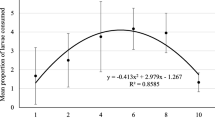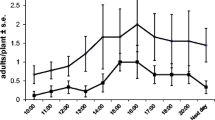The influence of prey mobility and species on prey selection by the coccinellid Harmonia axyridis Pallas was determined under laboratory conditions for two prey species, Hyaliodes vitripennis (Say) and Tetranychus urticae Koch. Prey selection was influenced by prey mobility. In the presence of active prey, the coccinellid selected T. urticae while in presence of immobilized prey, H. vitripennis was preferred. Harmonia axyridis searching time was longer in the presence of active H. vitripennis than in the presence of active T. urticae. Moreover, the coccinellid capture rate was lower for active H. vitripennis caused by effective defensive mechanisms. Prey suitability was affected by prey mobility and species. Immobilized H. vitripennis were the most profitable prey, i.e. induced a shorter developmental time and no mortality. However, active H. vitripennis were not a suitable food source for H. axyridis. Our results suggested that three factors are involved in prey selection by H. axyridis: (i) prey mobility; (ii) prey defensive mechanisms; and (iii) prey species.



Similar content being viewed by others
REFERENCES
Allan, J. D., Flecker, A. S., and McClintock, N. L. (1987). Prey preference of stoneflies: Sedentary vs mobile prey. Oikos 49: 323–331.
Arnoldi, D., Stewart, R. K., and Boivin, G. (1992). Predatory mirids of the green apple aphid Aphis pomi, the two-spotted spider mite Tetranychus urticae and the european red mite Panonychus ulmi in apple orchard in Québec. Entomophaga 37: 283–292.
Burgio, G., Santi, F., and Maini, S. (2002). On intra-guild predation and cannibalism in Harmonia axyridis (Pallas) and Adalia bipunctata L. (Coleoptera: Coccinellidae). Biol. Control 24: 110–116.
Carter, M. C., and Dixon, A. F. (1982). Habitat quality and the foraging behaviour of coccinellid larvae. J. Anim. Ecol. 51: 865–878.
Chouinard, G., Firlej, A., Vanhoosthuyse, F., and Vincent, C. (2000). Guide d’identification des ravageurs du pommier et de leurs ennemis naturels, Conseil des Productions végétales du Québec, Québec.
Chouinard, G., Roy, M., and Vincent, C. (1992). Ravageurs et faune auxiliaire des vergers de pommiers au Québec en 1992. Agriculture et Agroalimentaire Canada, Saint-Jean-sur-Richelieu (Québec). Résumé Des Recherches. 21: 7–9.
Cisneros, J. J., and Rosenheim, J. A. (1997). Ontogenetic change of prey preference in the generalist predator Zelus renardii and its influence on predator-predator interactions. Ecol. Entomol. 22: 399–407.
Clements, D. R., and Harmsen, R. (1990). Predatory behavior and prey-stage preference of stigmaeid and phytoseid mites and their potential compatibility in biological control. Can. Ent. 122: 321–328.
Cottrell, T. E., and Yeargan, K. V. (1998). Intraguild predation between an introduced lady beetle, Harmonia axyridis (Coleoptera: Coccinellidae), and a native lady beetle, Coleomegilla maculata (Coleoptera: Coccinellidae). J. Kansas Entomol. Soc. 71: 159–163.
Erickson, K. S., and Morse, D. H. (1997). Predator size and the suitability of a common prey. Oecologia. 109: 608–614.
Eubanks, M. D., and Denno, R. F. (2000). Health food versus fast food: the effects of prey quality and mobility on prey selection by a generalist predator and indirect interactions among prey species. Ecol. Entomol. 25: 140–146.
Hazzard, R. V., and Ferro, D. N. (1991). Feeding responses of adult Coleomegilla maculata (Coleoptera: Coccinellidae) to eggs of Colorado potato beetle (Coleoptera: Chrysomelidae) and green peach aphids (Homoptera: Aphididae). Environ. Entomol. 20: 644–651.
Houck, M. A. (1991). Time and resource partitioning in Stethorus punctum (Coleoptera: Coccinellidae). Environ. Entomol. 20: 494–497.
Jeschke, J. M., and Tollrian, R. (2000). Density-dependent effects of prey defences. Oecologia 123: 391–396.
Kajita, Y., Takamo, F., Yasuda, H., and Agarwala, K. (2000). Effects of indigenous ladybird species (Coleoptera: Coccinellidae) on the survival of an exotic species in relation to prey abundance. Appl. Entomol. Zool. 35: 473–479.
Kalaskar, A., and Evans, E. W. (2001). Larval responses of aphidophagous lady beetles (Coleoptera: Coccinellidae) to weevil larvae versus aphids as prey. Ann. Entomol. Soc. Am. 94: 76–81.
Koch, R. L. (2003). The multicoloured Asian lady beetle, Harmonia axyridis: A review of its biology, uses in biological control, and non-target impacts. J. Insect Sci. 3: 32.
Lucas, É., and Alomar, O. (2001). Macrolophus caliginosus (Wagner) as an intraguild prey for the zoophytophagous Dicyphus tamaninii Wagner (Heteroptera: Miridae). Biol. Control. 20: 147–152.
Lucas, É., Coderre, D., and Vincent, C. (1997). Voracity and feeding preference of two aphidophagous coccinellids on Aphis citricola and Tetranychus urticae. Entomol. Exp. Appl. 85: 151–159.
Michaud, J. P. (2002). Biological control of Asian citrus psyllid, Diaphorina citri (Hemiptera: Psyllidae) in Florida: A preliminary report. Entomol. News 113: 216–222.
Molles, M. C., and Pietruszka, R. D. (1987). Prey selection by a stonefly: The influence of hunger and prey size. Oecologia 72: 473–478.
Nordlund, D. A., and Morrison, R. K. (1990). Handling time, prey preference, and functional response for Chrysoperla rufilabris in the laboratory. Entomol. Exp. Appl. 57: 237–242.
Phoofolo, M. W., and Obrycki J. J. (1998). Potential for intraguild predation and competition among predatory Coccinellidae and Chrysopidae. Entomol. Exp. Appl. 89: 47–55.
Polis, G. A., Myers, C. A., and Holt, R. D. (1989). The ecology and evolution of intraguild predation: Potential competitors that eat each other. Annu. Rev. Ecol. Syst. 20: 297–330.
Provost, C., Coderre, D., Lucas, É., Chouinard, G., and Bostanian, N. J. (2005). Intraguild predation and insecticide: Impact on predation efficacy of mite predators. Pest Manage. Sci. 61: 532–538.
Roger, C., Coderre, D., and Boivin, G. (2000). Differential prey utilization by the generalist predator Coleomegilla maculata lengi according to prey size and species. Entomol. Exp. Appl. 94: 3–13.
Rosenheim, J. A., and Corbett, A. (2003). Omnivory and the indeterminacy of predator function: can a knowledge of foraging behavior help? Ecology 84: 2538–2548.
SAS Institute (2000). JMP In software, version 4.0.2., SAS Institute Inc., Cary, NC.
Schmidt, J. M., Taylor, J. R., and Rosenheim, J. A. (1998). Cannibalism and intraguild predation in the predatory Heteroptera. In Coll, M., and Ruberson, J. R. (Eds.), Predatory Heteroptera: Their Ecology and use in Biological Control, Thomas Say Publications, pp. 131–169.
Sih, A., and Christensen, B. (2001). Optimal diet theory: When does it work, and when and why does it fail? Anim. Behav. 61: 379–390.
Snyder, W. E., and Ives, A. R. (2004). Interactions between specialist and generalist natural enemies: Parasitoids, predators, and pea aphid biocontrol. Ecology 84: 91–107.
Soares, A. O., Coderre, D., and Schanderl, H. (2004). Dietary self-selectionby the adults of the aphidophagous lady beetle Harmonia axyridis (Coleoptera: Coccinellidae). J. Anim. Ecol. 73: 478–486.
Stephen, D. W., and Krebs, J. R. (1986). Foraging theory, Princeton University Press, Princeton.
Stuart, R. J., Michaud, J. P., Olsen, L., and McCoy, C. W. (2002). Lady beetles as potential predators of the root weevil Diaprepes abbreviatus (Coleoptera: Curculionidae) in Florida citrus. Fla. Entomol. 85: 409–416.
Sullivan, K. A. (1984). Age-specific profitability and prey choice. Anim. Behav. 36: 613–615.
Veeravel, R., and Baskaran, P. (1995). Effect of prey and predator age on the feeding preference and rate of predation by two predators Coccinella transversalis Fab. and Cheilomenes sexmaculatus (Coleoptera: Coccinellidae). J. Biol. Control 9: 26–29.
Villanueva, R. T., Michaud, J. P., and Childers, C. C. (2004). Ladybeetles as predators of pest and predacious mites in citrus. J. Entomol. Sci. 39: 23–29.
Waldbauer, G. P., and Friedman, S. (1991). Self-selection of optimal diets by insects. Annu. Rev. Entomol. 36: 43–63.
Yasuda, H., and Ohnuma, N. (1999). Effect of cannibalism and predation on the larval performance of two ladybird beetles. Entomol. Exp. Appl. 93: 63–67.
Yasuda, H., and Shinya, K. (1997). Cannibalism and interspecific predation in two predatory ladybirds in relation to prey abundance in the field. Entomophaga. 42: 153–163.
ACKNOWLEDGMENTS
We thank F. Courchesne and F. Pelletier for technical assistance. We are grateful to B. Fréchette, L.A. Giraldeau, J. Brodeur and H. Hodek for helpful and constructive comments. This research was supported by a grant from le Fonds pour la Formation de Chercheurs et l’Aide à la recherche du Québec (FCAR) to D. Coderre and G. Chouinard. C. Provost was supported by a graduate scholarship from the Institut de Recherche et de Développement en Agroenvironnement (IRDA).
Author information
Authors and Affiliations
Corresponding author
Rights and permissions
About this article
Cite this article
Provost, C., Lucas, É., Coderre, D. et al. Prey Selection by the Lady Beetle Harmonia axyridis: The Influence of Prey Mobility and Prey Species. J Insect Behav 19, 265–277 (2006). https://doi.org/10.1007/s10905-006-9023-6
Revised:
Accepted:
Published:
Issue Date:
DOI: https://doi.org/10.1007/s10905-006-9023-6




